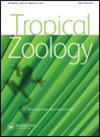巴西东南部剑蛾属二新种记述(毛翅目:剑蛾科)
IF 0.4
4区 生物学
Q4 ZOOLOGY
引用次数: 3
摘要
除了在巴西记录到的6种剑蛾(Xiphocentron Brauer, 1870)外,本文还描述并说明了两种新种:X. (Antillotrichia) acqualme n. sp.和X. (Antillotrichia) jaguare n. sp.剑蛾属的Caddisflies通常在白天活动,不容易被光吸引。然而,这里所有的物种都是在夜间用灯捕获的。新种可以很容易地通过在前翅上有一个小细胞包裹着nigma来区分。这些标本是在位于巴西东南部米纳斯吉拉斯州的一座重要山脉——卡纳斯特拉国家公园收集的。http://zoobank.org/urn:lsid:zoobank.org:pub:3DBCFECD-7CBD-4A80-9A3C-9C2FCD8FCEA1本文章由计算机程序翻译,如有差异,请以英文原文为准。
Description of two new species of Xiphocentron Brauer, 1870 (Trichoptera: Xiphocentronidae) from southeastern Brazil
In addition to the six species of Xiphocentron Brauer, 1870 currently recorded in Brazil, two new species of X. (Antillotrichia) are described and illustrated in this work: X. (Antillotrichia) acqualume n. sp. and X. (Antillotrichia) jaguare n. sp. Caddisflies in the genus Xiphocentron usually present diurnal activity and are not readily attracted to lights. However, all species included here were collected using light traps during nighttime. The new species can be easily distinguished by having a small cell enclosing the nigma on the forewing. The specimens were collected in the Parque Nacional da Serra da Canastra, a significant mountain range located in the state of Minas Gerais, southeastern Brazil. http://zoobank.org/urn:lsid:zoobank.org:pub:3DBCFECD-7CBD-4A80-9A3C-9C2FCD8FCEA1
求助全文
通过发布文献求助,成功后即可免费获取论文全文。
去求助
来源期刊

Tropical Zoology
生物-动物学
CiteScore
2.50
自引率
0.00%
发文量
1
审稿时长
>12 weeks
期刊介绍:
Tropical Zoology is an international zoological journal publishing original papers in the field of systematics, biogeography, phylogeny, ecology and conservation of all terrestrial and aquatic animal Phyla from tropical and subtropical areas.
Only papers with new information, high quality and broad interest are considered. Single species description and checklists are not normally accepted. Review papers are welcome. The journal is owned by the Istituto di Ricerca sugli Ecosistemi Terrestri of the Consiglio Nazionale delle Ricerche, Florence, Italy (CNR-IRET) who performs research into the structure and functioning of aquatic and terrestrial ecosystems, focusing in particular on anthropogenic pressure and global change. The knowledge amassed forms the scientific basis for identifying the most appropriate protective and corrective interventions, and provides support for the bodies entrusted with formulating policies for environmental protection and recovery.
 求助内容:
求助内容: 应助结果提醒方式:
应助结果提醒方式:


